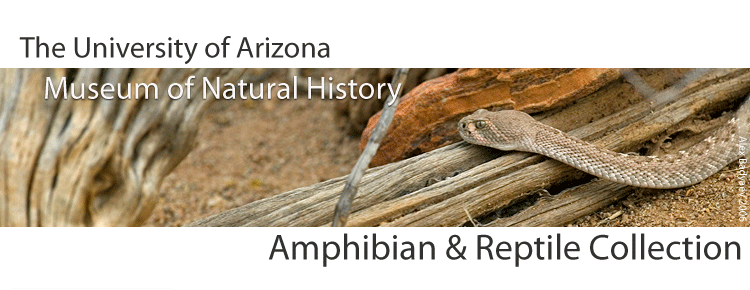From 1910 through the 1920s, University of Arizona
Zoologist Charles T. Vorhies and Walter P. Taylor of the U.S. Biological
Survey took specimens from Southern Arizona that eventually made
their way into the collection. From the 1930s through the late 1940s
collectors such as E. C. Jacot, C. W. Quaintance, A. J. Van Rossem,
as well as W. P. Taylor, and C.T.Vorhies added to the university’s
holdings. By in large, these specimens were taken almost incidentally
as these early collectors busied themselves with the more prescribed
activities of their professions and objectives. By 1950, the collection
consisted of approximately 2,500 specimens, the majority of these
being from the Tucson area and Southern Arizona.
It is probably safe to assume that these pioneer
collectors had little or no inkling that the specimens they gathered
during the first few decades of the 20th century would form the
nucleus for one of the great regional legacy collections of the
western United States.
In 1950, Dr. Charles
H. Lowe (recently deceased professor emeritus in the Department
of Ecology and Evolutionary Biology), arrived at the University
of Arizona after receiving his doctorate degree under the guidance
of Dr. Raymond B. Cowles at the University of California at Los
Angeles. Lowe, a premiere naturalist, and being an energetic and
dynamic herpetologist with insights into a multitude of disciplines,
set out immediately to build the collection. He brought with him
a personal collection of some 1,500 specimens, largely from New
Mexico, California, and Baja California. Lowe’s heterogeneous
interests and areas of expertise attracted a wide variety of students
who, under his direction, made advances in fields ranging from genetics,
systematics, and physiology, to population biology and the classification
of biotic communities. During the 1950s and 1960s, Lowe, his students,
and associates made extensive collections from the Southwestern
United States and Mexico. A complete list of collectors during this
“Golden Age” of collecting at the University of Arizona
would be far too great to present here, but some of the principle
contributors include, in alphabetical order: Kenneth K. Asplund,
Robert L. Bezy, Arthur D. Cecil III, Charles J. Cole, Robert. W.
Dickerman, Richard S. Felger, J. Homer Ferguson, Gerald O.Gates,
Stephen R. Goldberg, Penelope A. Graf, Elizabeth A. Halpern, Wallace
G. Heath, Peter J. Lardner, Joe T. Marshall, Kenneth S. Norris,
Arthur J. Ruff, Wade C. Sherbrooke, Oscar H. Soule, Allen E. Thomas,
John W. Tremor, John W. Wright, and Tien W. Yang. Lowe also made
collections on trips abroad during tours of the deserts and arid
lands of the Old World, as well as forays into Central and South
America.
By the early 1970s, the rapid pace of collection
building that so typified the 1950s and 1960s began to moderate,
and large scale mass collecting shifted into more prudent sampling
of populations and regions. Though collection growth has decelerated
somewhat, the collection remains dynamic. From the early 1970s to
the present, many workers have made valuable additions to this institution.
Some of the more paramount of these acquisitions include (in alphabetical
order) collections by Richard A. Blake, George L. Bradley, Tony
L. Burgess, John K. Cross, Darrel R. Frost, Stephen F. Hale, Peter
A. Holm, C. Wayne Howard, James A. Hudnall, Terry B. Johnson, Brent
E. Martin, Michael D. Robinson, Philip C. Rosen, Julia V. Salmon,
Shawn S. Sartorius, Cecil R. Schwalbe, Dale S. Turner, and Thomas
R. Van Devender. This period has also seen several important acquisitions
from other institutions. Unquestionably, the most important of these
acquisitions being the donation of over 2,100 preserved specimens
from the Arizona-Sonora Desert Museum. This ASDM collection, principally
composed of material collected from the Southwestern United States
and Northern Mexico during a period that spanned the 1940s through
the 1980s, was largely built by William H. Woodin, Mervin W. Larson,
Merritt S. Keasey, and others affiliated with the Desert Museum.
The UAZ Herpetology Collection continues to be a
major repository of voucher material for a wide array of studies
and projects in the southwestern United States. Recent faunal surveys
and ecological studies have added valuable specimens from a number
of parks, monuments, conservation areas, refuges, and military reservations,
as well as other locales of federal, state, and private stewardship.
These specimens, whether collected a hundred years ago or today,
constitute the “baseline” in studies ranging from systematics
to reproductive biology, parasitic infection, disease outbreak,
diet, activity periods, and distribution in both space and time.
When taken as a whole, these specimen-based disciplines form the
core for very important and much needed work in conservation biology,
and provide us with a glimpse into what was, what is, and what the
future may hold.

